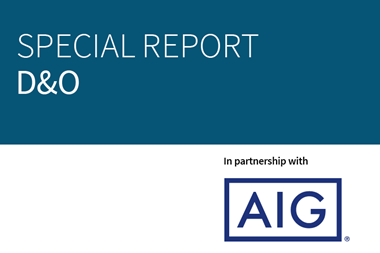Directors and officers need to be on top of the opportunities and threats of Brexit

British Prime Minister Theresa May has made it clear: Brexit means Brexit.
But for businesses in every sector precisely what impact the referendum result will have on their operations is much harder to fathom. But fathom it they must if they are going to stay on top of their directors’ and officers’ (D&O) risk.
Leaders have now had plenty of time to make plans. Any company not able to demonstrate its preparedness is going to look exposed and the last thing investors want to hear anyone saying is: “We don’t know. We’ll wait and see.”
Brexit has the potential to be a serious event for the unprepared. “If business leaders mismanage this risk, if they miscommunicate it to the market, they could be held accountable,” says John Hopper, UK head of financial lines at AIG.
“It’s as simple as that. If you say things today that later turn out to be untrue, you will be held responsible. The stakes are high in all sectors from finance to retail and across all areas of those businesses and, as a result, D&O needs to be a boardroom issue.”
Funds closed
An early example of one way that Brexit could change D&O risk emerged soon after the referendum result was announced, with the closing of many big commercial property funds as investors rushed to withdraw capital. This may have affected the value of those funds.
Nick Williams, head of Kennedys Law insurance division, says: “It follows that any decisions made by D&Os in the period leading up to 23 June that were dependent on such valuations may now come under attack and lead to claims.
“The directors and officers of companies that failed to plan adequately for a leave vote in the Brexit referendum may be vulnerable. It may be claimed that they failed in their obligations by not taking adequate precautions.”
In this environment it is vital to stay one step ahead. Boards must identify their principal risks, assess them and get assurance from management that they are being adequately managed.
“Directors are facing greater scrutiny and demands for sharper governance,” says Airmic deputy chief executive Julia Graham.
“In a world of greater complexity, with change at increasing velocity fuelled by technology, whatever sector forms the context of the directors’ business, the role of director is ‘high octane’ and one where the role demands transformation, not evolution. Evolution infers time – time is not on their side.
“D&O liability insurance cover should be a board agenda item.
“Directors should consider a legal health check is undertaken across their wordings with brokers and insurers. The FRC Code, Cyber and, now, Brexit all have potential director exposures. Boards should not be complacent and be confident they understand them.”
Since the EU referendum there have already been significant changes and there will be more to come over the next few years. Trends and step changes in the business context will emerge.
John Ludlow, executive director of Leading In Risk, says: “Shareholders have a right to expect that their boards are on top of both these opportunities and threats.
“Failure to reasonably protect or take opportunities that others see may leave directors liable.
“Now is not the time to be complacent. Business models need to be reviewed in the new and emerging context for business in the UK. Changes, threats and opportunities need to be identified, assessed and prioritised. All business strategies then need to be reviewed and refreshed.”
To do this, risk and strategy managers need to work together with senior managers to identify risks to the business model, strategy, markets and stakeholders such as suppliers, staff, and partners.
“They need to prepare to support the board to assess the risks fully, then work with senior managers across the business to develop strategies for the board to consider,” says Ludlow.
Planning for change
Any changes need to be absorbed into the business planning cycle and change programme.
“If significant change is envisaged, a Brexit transformation programme may be necessary,” says Ludlow. “It may be necessary to beef up the quarterly business review to consider the risks as they emerge.”
Risk managers should be aware that their “risk register” may not be the best way to present new information to the board.
Institute of Risk Management Technical Director Paul Hopkin says it is the responsibility of the risk manager to make the information dynamic, relevant and aligned with the business model and strategy of the company, rather than a static snapshot that produces a list of risks that seem disconnected from board member priorities.
“The fact that UK boards are challenged with the obligation to develop a longer-term viability statement has resulted in better engagement of board members with risk management and enhanced the board discussion of risk,” he says.
But while leaders may be more aware of risk, many are still unclear on how they might be affected by it, says Mark Simpson, head of consultancy at Armour Risk Management. “There’s lots of information and misinformation but little that’s concrete yet.”
For this reason it’s also the risk manager’s job to help make sure firms have the right D&O cover in place, says Leslie Kurshan, head of product development in the financial and professional practice at Marsh.
“Brexit presents management challenges, which in turn creates D&O risk. Now is the time to review your executive protection programme to make sure that it is robust and that you understand your obligations in relation to it.
“[It] should be reviewed regularly and considered in the context of real life risks.
“With regard to D&O insurance, the inquiry should go beyond confirmation that the company purchases the policies and the amount of the limits in place,” Kurshan says. “The terms of D&O policies vary widely, particularly in relation to cover for evolving risks like informal and internal investigations.”
And, for the cover to be useful, key people need to understand their obligations under it, so that they comply with the terms.
“Be sure that you understand what needs to be notified and disclosed to insurers so that rights under your insurance aren’t inadvertently lost for failure to do so,” warns Kurshan.
It’s also worth remembering that Brexit may not only affect what cover is needed – but also where that insurance is bought.
At the moment, companies can buy their D&O cover from a UK-based carrier that will cover their European operations. But, depending on the negotiations, it may be that in the future an insurer will no longer be able to provide this service from London.
“In those circumstances, companies wanting to buy D&O that would be effective around their European operations might need to purchase individual policies in EU countries issued by an insurer licensed to operate in all those territories,” says Williams.
But in the coming months and years perhaps the biggest risk for individual companies – and the broader economy – is that decision-makers simply stop taking their businesses forward. Smart firms will use their D&O insurance as an enabler.
“If company boards decide to delay all strategic investment pending a clearer picture it is feasible that this would lead to two or three years of complete inaction,” says Williams.
“Inaction for that length of time would probably be the worst possible approach.
“It may be, therefore, that the best approach is ‘business as usual’, but on the basis that when a decision is made, consideration should be given and matters arranged so that adjustments can be made at short notice to take into account changes in trading relationships with EU countries.”
Prepare and protect, but stay nimble. And remember: risk and opportunity are two sides of the same coin.




















No comments yet